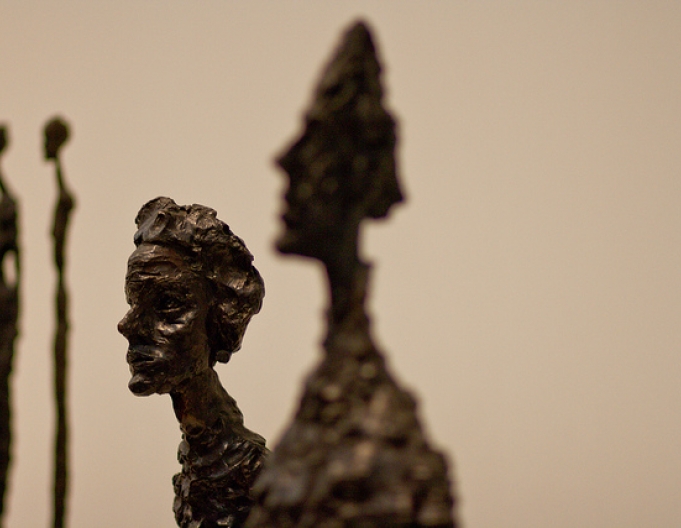One day when I was drawing a young girl, I suddenly noticed that the only thing that was alive was her gaze. The rest of her head meant no more to me than the skull of a dead man. One does want to sculpt a living person, but what makes him alive is without doubt his gaze… Everything else is only the framework for the gaze.
To estimate how great an artist is, you should compare his most significant period to our current age. Take the Swiss sculptor and painter Alberto Giacometti, for instance. It was around 1946-47 that he became Giacometti.
Paris of that epoch was living the golden age of the neighborhood of Saint Germain-des-Prés and of the philosophical and cultural existentialism movement where people dressed in all-black, listened to jazz in dark cafes, and where the poet Jacques Prévert, the singer Juliette Gréco, and the filmmakers Jean-Luc Godard and François Truffaut could be spotted around the next corner.
But to see these people for real, you had to look at least once at the skeletal figures Giacometti molded to represent them.
“Homme qui marche” (The Walking Man) is Giacometti’s most famous work that lends its name to the exhibition, which runs until November 18 in Fort Bard, in the Italian Aosta Valley.
The sculptor created a man beyond time, part in the past and part in the future. His works represent the doubts about destiny that were at the origin of the philosophy explored by jean-paul-sartre, Jean-Paul Sartreand, Albert Camus. They represent walking without a clear destination, which in the same years was expressed in Jackson Pollock’s nomadic drippings, the tangles of the Informal art, the surfaces without cardinal points of the all-over painting.
But they say something else. Whether tiny or gigantic, his figures recall the linearity of his-chauffeur-electrician-and-mysterious-50-million-stash-picassos, Pablo Picasso’surreal period, and some Etruscan or Egyptian sculptures. Sometimes you can look at them and ask yourself if you are at an exhibition of 20th century art or in an archeological site. They make us think about that unchangeable something that man, woman, and even animals have kept through the centuries.
Giacometti looked for this unaltered essence: the instinct of life and death that has not been altered from the creation of the first living cell to our era of the cell phone. His figures lack any details or tools, and thus become universal.
A small-town artistic family
Over 100 sculptures, paintings, and drawings from the Maeght collection on display at Fort Bard, give an exhaustive idea of the sculptor. The exhibition begins with early works such as Head of a Young Man, or Portrait of Diego, from when Giacometti was 16 or 17 years old.
The artist was born in 1901 in the small Italian-speaking village of Borgonovo di Stampa in the alpine Val Bregaglia valley, and came from an artistic family. His father, Giovanni, and his cousin, Augusto, were painters. One brother, Diego, was a designer, and the other brother, Bruno, was an architect.
Despite growing up in this evocative mountain background, Giacometti later decided to live in Paris. The engravings Paris Sans Fin (Never Ending Paris) are on display. But during his childhood, Stampa was an enchanted world, all made of stone. He wrote that when he was 5 or 6 years old, “for at least two summers in a row, among everything that surrounded me, I could only see a huge stone which was 800 meters away from the village. It was a golden monolith at the entrance of a little cave. I felt full of joy when I could huddle up at the bottom of the little cave. All my wishes were fulfilled.”
In 1922, Giacometti decided to move to Paris to study under the famous symbolist sculptor Antoine Bourdelle. Later he became acquainted with André Breton and Surrealism. In this period, he created works such as Man and Woman, 1926-1927; Composition and The Invisible Object, 1934-1935. Giacometti found in Surrealism his same love for African art and the will to make the urges of the unconscious emerge in the sculptures. Still, his central theme was always the human being, of whom he explored the subtle cruelty hidden behind an erotic masque.
He was interested in surreality but in reality too. For this reason in the 1930s he moved away from Breton. He went through a realistic period and eventually arrived to his drained figures which merge all the categories, and are at the same time abstract, figurative, expressionist, and surreal. His sculptures come from his unstoppable intellectual attraction for Egyptians, Sumerians, Greeks, Etruscans, Flemish, of whose works he made many copies. Maybe, today they look so contemporary because they are also so archaic.
“All the art of the past rises up before me, the art of all ages and all civilizations, everything becomes simultaneous, as if space had replaced time. Memories of works of art blend with affective memories, with my work, with my whole life.”
